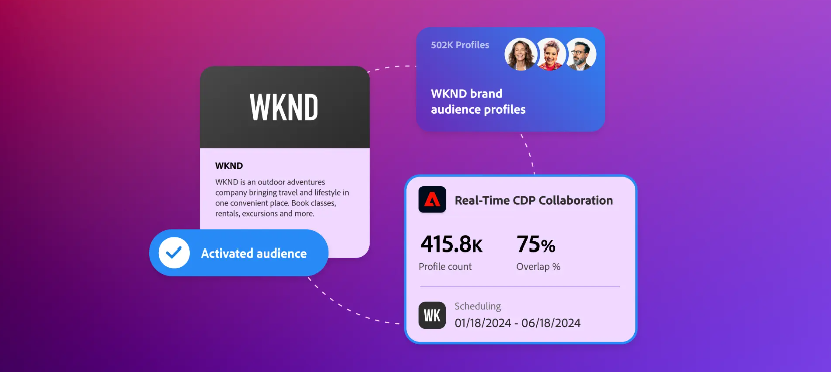Beyond composable — Federated Audience Composition in Adobe Real-Time CDP and Adobe Journey Optimizer
April 5, 2024This article was originally published on Adobe website. Click here to see the original blog post.
In our conversations with customers, sometimes they ask, “Can I just use my data warehouse as a customer data platform (CDP)?”.
Every organization searches for opportunities to drive efficiency, such as repurposing existing technology investments to minimize costs and eliminate redundancies in technology and processes. Plus, IT and marketing teams want the flexibility to select the appropriate technology solutions to meet the requirements of the business.
To address this challenge, Adobe is introducing Federated Audience Composition in Adobe Experience Platform, uniquely designed to help our customers compose data across use cases. With this new approach, customers of Adobe Real-Time CDP and Adobe Journey Optimizer can use data from their data warehouse partners directly to enrich existing high-value audiences and attributes all in one single system. This new capability provides customers the flexibility to act on use cases across the enterprise ranging from micro-segmentation to in-the-moment personalization with low-latency activation. Federated Audience Composition allows Adobe customers to decide what data to use when and avoid unnecessarily duplicating data sets or integration patterns.
Taking a different approach
Within the data management space, the concept of “composable CDPs” has taken shape suggesting prospective Customer Data Platform buyers simply use a thin activation layer on top of their existing data warehouse. However, this strategy by itself falls short when attempting to power real-time use cases.
Composable architecture describes an approach to building a technology stack that assembles various individual components to build a complete solution tailored to specific business needs. This differs from packaged, seamless solutions that offer a complete set of capabilities designed to work together natively.
The composable approach has been repurposed by some CDP vendors to describe an unbundling of services that would typically be included with the purchase of a customer data platform. These services may include data ingestion, identity resolution, profile creation, segmentation, AI and machine learning features, and prebuilt destinations for activation. Some “composable CDP” offerings take this to an extreme, simply providing an activation layer on top of an existing data warehouse so data might be egressed in batches for use cases like email sends. This approach, at face value, may streamline architecture diagrams and seem like a straightforward solution, but upon closer inspection its limitations become clear. For example, activation of data is just one piece of the puzzle — data warehouses need to have proper identity resolution and data enrichment capabilities to ensure brands are acting on accurate data.
Enterprise data warehouses are optimized for long-term storage of organization data, which often includes data about customer engagement and customers themselves. Data warehouses are an essential component of first-party data management, with IT teams running SQL queries against that data for insights and audience creation, and data scientists leveraging datasets for modeling and business intelligence. These are analytical workflows that in many cases are essential for running and optimizing a business. However, these systems fall short when the data residing in enterprise warehouses needs to be made actionable for engagement workflows. Latencies when accessing critical datasets translate to limitations when marketing teams need to deliver personalized experiences in seconds or milliseconds.
Real time is mission critical
While a visitor is on your site or in your app, you need to engage and personalize in the moment to have a chance at winning their business. After a purchase is made, you then must suppress or requalify that customer from paid media to ensure relevancy and conserve advertising dollars and marketing spend. When a frustrated customer dials the call center, the representative handling that call needs to know up-to-the-second information about how that customer has recently engaged with the brand to ensure they retain the customer and continue to build a lasting relationship. For example, knowing when to tone down or cease marketing outreach based on what’s going on for a customer is key. These are all examples of engagement workflows that require a low-latency system that can make customer data actionable in the moments that matter. A latency in data warehouse audience qualification could mean missing the opportunity to deliver the right experience to a customer.
The CDP Institute defines a customer data platform as “packaged software that creates a persistent, unified customer database that is accessible to other systems.” Without a persistent, unified customer database, the “composable CDP” solutions in market do not qualify as CDPs on their own, but only offer CDP capabilities when paired with a data warehouse. Among the promoted benefits of this approach are easy access to the data warehouse sources of truth, the ability to avoid copying data into multiple systems, and a seemingly lower cost of ownership. Unfortunately, the sacrifices of this approach are often not made clear and may not be realized until it is too late.
- When attempting to repurpose a data warehouse as a CDP profile store, inherent data processing and egress latencies make it challenging, if not impossible, to meet marketer and customer expectations for personalization.
- Applications outside the data warehouse require a copy of the data. Some vendors promote “zero data copy,” but the reality is data warehouses alone are not equipped to handle all use cases, particularly use cases which require real-time workloads to support in-the-moment engagements. To do this many organizations will ultimately require a replication of data from the data warehouse to the applications that need that data to function for necessary use cases. Despite the promise, data copy still does happen.
- Total cost of ownership should include all the costs associated with a “composable CDP” approach. This means factoring in data warehouse fees for the long-term storage of incremental data sources — for example, event-level data that might traditionally be retained for limited duration in a packaged CDP — and the cost of frequently retrieving data from the data warehouse for customer engagement use cases. This may be significant due to the cost for egress from a data warehouse to other systems, especially when done in a recurring manner.
- Data warehouses are designed to collect, manage, and analyze data, but additional needs are required to deliver CDP-like capabilities. This includes enrichment and collaboration tools, profile management capabilities including identity resolution, and a marketer-friendly UI.
A purely “composable CDP” may seem like an inexpensive way to take advantage of existing data warehouse investments while activating data to destinations, but this approach may not meet the use case requirements of brands. Ultimately the desire to maximize the value of a data warehouse investment should be balanced against the latency and workflow requirements to meet customer expectations for personalization and relevant experiences. Customers need to carefully evaluate their current and future business goals as they make this decision. Investing in a technology design today that will need a redesign later is a costly affair and should be factored into the decision-making process.
Compose the data, not the application
Adobe Experience Platform applications, including Real-Time CDP and Journey Optimizer, are built from the ground up to support engagement workflows that power audience-based and in-the-moment experiences. Each application is recognized as an established leader in its respective category. Customers using these applications ingest the data needed to power their use cases into Experience Platform’s profile service, which maintains constantly updated, actionable profiles. While traditional systems and “composable CDPs” can support audience-based, batch activation, Adobe follows a marketer-initiated activation pathway, helping the marketer initiate one-to-one interactions in the moment. Real-Time CDP is intended to augment an existing data warehouse investment by making a subset of the data residing in the warehouse actionable for engagement workflows — but this is not a copy of everything in the data warehouse. Additionally, Journey Optimizer natively uses the same profiles and audiences for orchestration and delivery of omnichannel personalized experiences.
Data pervades organizations of all sizes, sourced from various channels and stored in diverse formats and platforms. The surge in digital and social media has amplified data volume, leading to silos that hinder insights crucial for decision-making. Customer data platforms emerged to minimize data chaos, and expectations have evolved beyond mere consolidation. Brands expect to access data from disparate systems for engagement use cases, and dynamics like data residency, redundancy, and data minimization have caused some organizations to rethink what data should be ingested into their CDP.
Adobe is introducing Federated Audience Composition in Experience Platform to access and create audiences with corresponding high-value attributes from enterprise data warehouses, which enrich and supplement the real-time customer profile and audiences in Experience Platform for improved segmentation, targeting, activation, and delivery of impactful customer experiences. Using Federated Audience Composition, a virtual database is created by linking remote databases through metadata. This approach simplifies access, reduces duplication, and enhances end-user experience. Teams are granted the flexibility to ingest datasets directly into Experience Platform or access datasets residing in data warehouses when assembling audiences for engagement workflows. This approach takes advantage of data warehouse investments and assets to complement Real-Time CDP and Journey Optimizer. Federated Audience Composition enables customers to utilize and combine batch and real-time functionality across critical new use-case patterns:
- Federated audience segmentation. A team can author an audience using the marketer-friendly drag-and-drop audience composition UI in Real-Time CDP and Journey Optimizer, but with a query pushed to the data warehouse, leaving sensitive underlying data in the warehouse without duplication and providing flexible access to essential datasets.
- Audience enrichment. Audiences built in Real-Time CDP and Journey Optimizer can be enriched with additional enterprise data to improve targeting and personalization with additional profile-based and non-profile-based datasets that will not persist in Adobe Experience Platform. For example, a retail brand may supplement an audience of recent online purchasers with a list of top brick-and-mortar locations to build an audience for a cross-channel online and in-store promotion.
- Profile enrichment. Teams can select profile attributes from the data warehouse that are critical for in-the-moment experiences to be retained within actionable customer profiles residing in Real-Time CDP and accessed via Journey Optimizer. These additional data points are then available for downstream segmentation and personalization triggered by event behaviors depending on the user action and customer use case. This will allow attributes brought along with federated audiences to be available for in-the-moment segmentation and personalization, alongside other attributes and behavioral signals retained in a customer profile.
Federated Audience Composition provides Real-Time CDP and Journey Optimizer customers with the flexibility to decide what data they want to use when and helps avoid unnecessarily duplicated datasets or integration patterns. This represents a unique combination of a federated approach to using enterprise data to curate audiences and high-value attributes, combined with a system optimized for in-the-moment cross-channel engagement. This results in less data movement, but also new opportunities to utilize high value audiences and attributes for consistent low-latency activation across channels.
Sometimes, a solution that seems too good to be true is just that. The purely “composable CDP” approach falls short of meeting customer and marketer expectations for low latency use cases and personalization in moments that matter. Rather than attempting to compose an application, brands should focus on composing their data to make the necessary datasets for their use cases accessible and actionable. With Federated Audience Composition in Real-Time CDP and Journey Optimizer, brands have the autonomy to decide what data should be retained in which system, without sacrificing their ability to execute engagement use cases for better customer experiences.


